Pyrola americana (Pyrola rotundifolia), roundleaf pyrola, dwells in mature woodlands. This petite herbaceous perennial native plant can be found on open forest floors and blooms in early summer.
Flowers
Pyrola americana - Pyrola rotundifolia has many scientific names as well as common names including roundleaf pyrola, American wintergreen, American shinleaf. All the Pyrolas - wintergreen/ shinleaf (Pyrolaceae) family are now considered a subfamily of the heath (Ericaceae) family There are 3 species of pyrola in NJ, one is rare but two are reasonably common. An attempt will be made to distinguish the two more common species: P. americana and P. elliptica
Inflorescence - flower cluster:
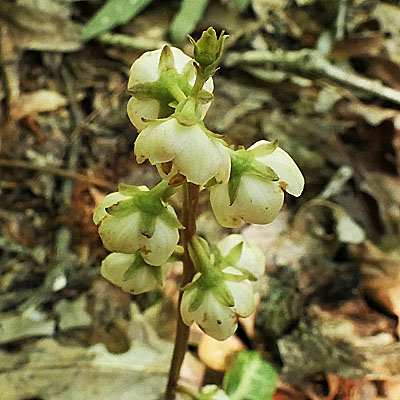
The Pyrola americana flower cluster forms an erect raceme with about 6 to 20 nodding flowers. A raceme is a unbranched stem with flowers attached to the stem with stalks which are called pedicels.
The flowers mature from the bottom up and frequently, there are flower buds on the top of the cluster.
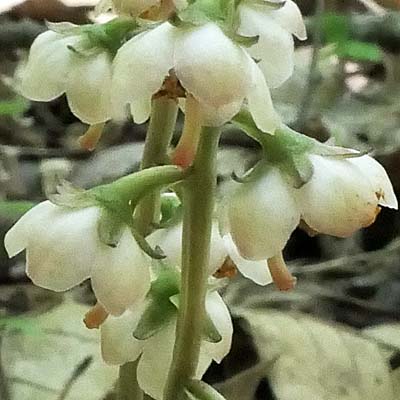
Individual flowers: What do the flowers really look like?
The nodding bell-shaped flowers are white with tinges of pink or green. The 5 petaled flower measures about a half inch across.
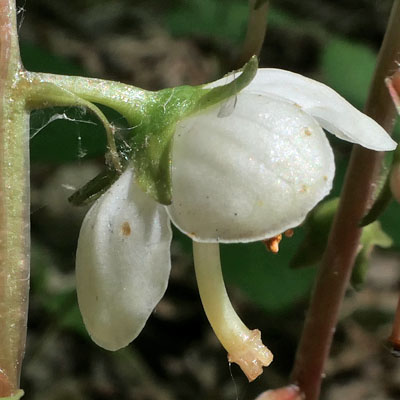
In the P. americana flower above, the long structure extending downward beyond the petals, like an elephabnt's trunk, is the elongated style with the pinkish stigma at the end .
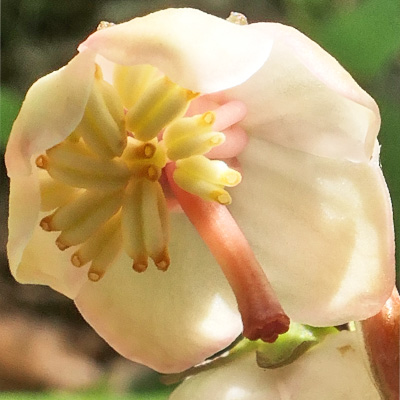
With the flowers facing downard, it is difficult to see under the petals especially since the flowers are also low to the ground.
The 10 stamens bend and crowd under the petals of the outer side and the reddish stigma extends downward.
The ovary is green and globose and is hidden by all the stamens.

In plants that have anther with pores, the pores are generally located at the distal (far) end of the anther. However, in P. Americana, the photo shows the filament connected to the anther that is folded over and the pores are at the base of the anther close to the junction (arrow). Also, the 5 lobes on the stigma are visible.
The pistil in detail: female reproductive structure - ovary, style, and stigma. In P. americana, the pistil is the fusion of 5 carpels. A single carpel has an ovary, style and stigma. However, only the stigma with its 5 lobes indicate that there are 5 fused carpels.

Close up of the 5 lobes on the stigma show that the pistil is composed of 5 fused carpels. The second photo, the flower is in the fruiting phase and the separated styles are visible.
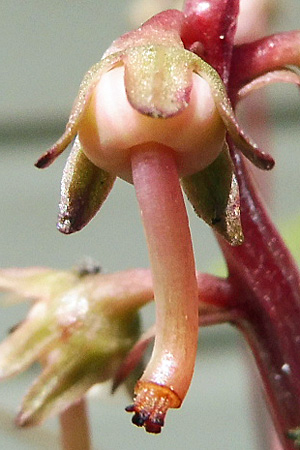
The flower is begining to fruit and the unneeded petals and stamens have been dropped. The globule ovary, developing fruit, is conspicuous.
The stamen in detail: male reproductive structure - filament and anther. This plant releases its pollen through pores in the anther and is said to exhibit 'poricidal dehiscence'.
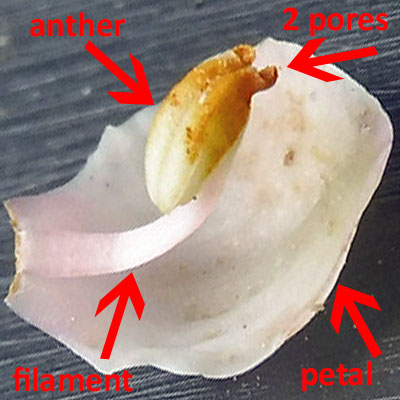
Each stamen has a filament and an anther with two chambers (2 thecae). The anther is creamy white and reflexs back toward the flower base. At the inflection point, each chamber (theca) has a pore that would normally face downward. The anther turns brownish with age.

The top photo shows a close up of the pores and the lower photo shows the pollen coming out of the pores.
Pollination: In P. americana the pores open downward but to conserve pollen it is sticky and does not just fall out. The flowers offers no nectar reward to their pollinators. However, pollen is very nutrient/protein rich, energetically expensive for the plant to make, and is highly desired by insects. The pollen is the reward for 'buzz pollinators'. Buzz pollinators are mainly bees, e.g. bumble bee. Not all bees are buzz pollinators. Buzz pollinators use vibrations to extract pollen from flowers and incidentally pollinating them when they go from flower to flower. Later the bee grooms the remaining pollen from its body into pollen-carrying structures and transports the pollen back to the nest.
During buzz pollination, bees use their thoracic (flight) muscles to produce vibrations which cause pollen to be shaken up inside the anthers and then be forcefully propelled outside the anther and onto the bee's body. The bee creates vibrations of up to 400 Hz, or 24,000 vibrations per minute, an audible middle-C buzz. The bee grasps the anther with its legs and vibrates its body. The flight muscles vibrate very rapidly without moving the wings. The bee lays its wings flat against its back and effectively uncouples the wings from the flight muscles, so the body vibrates instead. This vibration shakes electrostatically charged pollen out of the anthers, and the pollen is attracted to the bumblebee's oppositely charged body hairs.
Many genera including Pyrola, Vaccinium (blueberry etc), Solanum (nightshade), Gaylussacia (huckleberry) and Chimaphila (wintergreen), exhibit poricidal dehiscence. Buzz pollination is frequently associated with poricidal dehiscence. Many agriculturally important plants like potatoes, tomatoes, eggplants, peppers, pumpkins, zucchinis, blueberries and cranberries are buzz pollinated. It is estimated that about 58 percent of bee species can buzz pollinate.
Sepals - why a special section: Diagnostic characteristics include the sepals that are used to distinguish P. americana from P. elliptica and other pyrola.
The sepals are frequently refered to as calyx lobes or calyx bracts.
In Pyrola americana the sepals are longer than they are wide and are about 35 to 60% as long as the petals. The sepals do not overlap at the base. Their shape is oblong (sides nearly parallel) or ovate-oblong (the parallel sides widen/open up at the base somewhat). The sepals do not rapidly go to a sharp point at the tip
In Pyrola elliptica the sepals are as wide or wider than they are long and are about 25% long as the petals. The shape is more triangular. The sepals rapidly comes to a longer sharp point. I will be doing a page on P. elliptica and will provide photos.
However, sometimes the distinctions are not always clear.
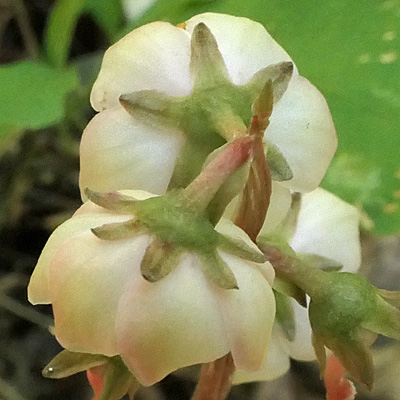
The shape of the sepals in Pyrola americana are clearly visible. The sepals are longer than they are wide and not overlapping. Their shape is oblong (sides nearly parallel) or ovate-oblong (the parallel sides widen/open up at the base somewhat). The sepals do not rapidly go to a sharp point at the tip. The length of the sepals relative to the length of the petals is 35 to 60%..
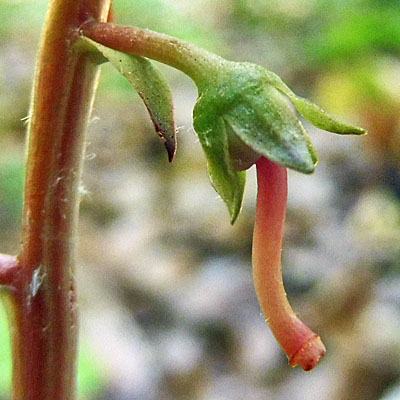
The shapes of the sepals can be clearly seen on this developing fruit. Also seen is the flower stalk (pedicel). The bract, at the junction of pedicel and the plant stem, is clasping and is as long as the pedicel.
Fruit
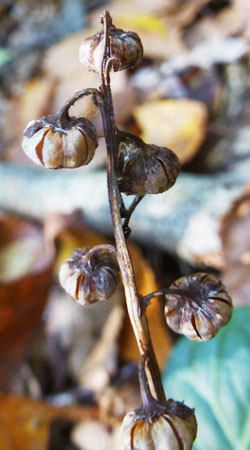
The fruit is all dried up. Frequently the dried stigma remains.
Numerous brown seeds are produced and they are wind dispersed
Leaves
The leaves are basal and evergreen so you can see them even in the winter. They are somewhat leathery and shiny. Recognizing the leaves is a big step in distinguishing P. americana from P. elliptca. Frequently only the leaves are available to look at.The leaves are up to 3 inch long and depending on their shape about 2.5 inches wide.
The most distinctive characteristic of the leaves are the light yellowish/whitish green vein pattern and the slight puckering in between the veins. From the photos below, this feature is more prominent in some leaves than others. I checked iNaturalist for NJ, research grade, all the photos of leaves had this feature. However, in some other locations, the vein pattern is there but not the coloration and the leaves do not look as heavy.
The shape of the leathery leaves are a bit variable from ovate to elliptic to obovate and round. However, sometimes the distinctions are not always clear.
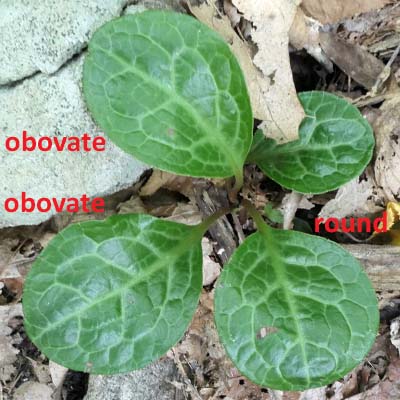
Obovate leaf shape: length longer than width and the broadest half is above the middle. In P. americana, these leaves frequently have rounded tips and 'V' shaped bases.
Round leaf shape: almost circular.
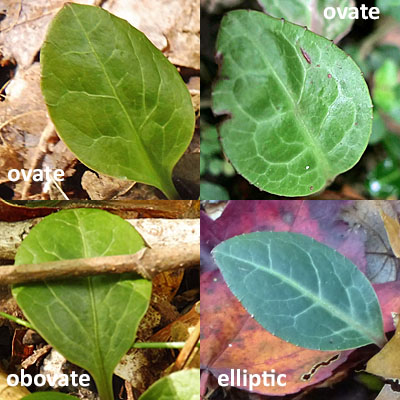
Here are more leaves: ovate (broadest at the base), obovate and elliptic (broadest at the middle). Some of the light colored veins are whitish and some are very narrow.

Here is the underside. Little teeth along the margin of the leaves are apparent. The obovate leaf has a pointed tip.
Also seen are young flower stalks and their buds
Plant
The plant is up to about 12 inches tall.
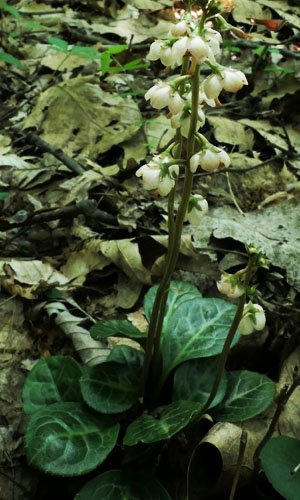
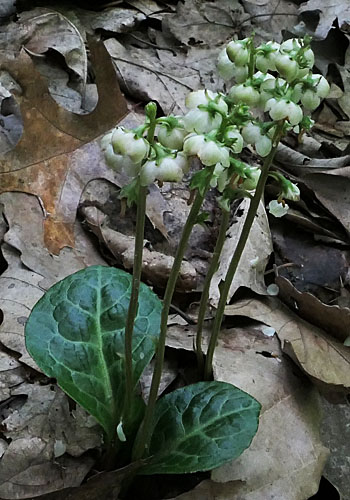
Habitat
Habitat: Pyrola americana grows in the shadow of the trees in the forest.
Research has shown that Pyrola americana is a mixotroph. This means that it can use a mix of different sources for energy and carbon.
The seeds are tiny and are referred to as 'dust seeds' and do not have any food storage for the seed to develop. It depends on mycorrhizal fungal relationships to obtain carbon. The seedling remains underground for a significant duration and relys on the fungal relationship to grow. This is termed as full myco-heterotrophy. This has been studied extensively in orchids.
However, as a adult plant, P. americana has green leaves so it is obvious uses photosynthesis for energy and uses atmospheric CO2 to generate the carbon compounds - sugars- that it needs. If the plant gets all its carbon needs from photosynthesis then it exhibits autotrophy. For a plant that appears to have a limited amount of sunlight it would be reasonable to suspect the plant utilizes additional sources of energy. Research has shown that P. americana also exhibits partial myco-heterotrophy as a adult.
The P. americana plant as a myco-heterotroph has ecological relationships with mycorrhizal fungi. Pyrola gets some of its carbon compounds from the mycorrhizal fungi while apparently not giving the fungi anything in return! The cost to the mycorrhizal fungi is still being studied.
So this is just part of the scenario. Where does the mycorrhizal fungus get the carbon compounds to give to myco-heterotrophs? The fungus forms mycorrhizal relationships with most other plants that photosynthesize such as trees. However, this relationship is mutualistic. For example, trees would provide carbon compounds - sugars- to the fungus and in return the fungus would provide nitrogen and other nutrients that it gets from the soil to the trees. Then the fungus can share with myco-heterotrophs like pyrola.
Studies have shown that P. americana also gets nitrogen compounds from the mycorrhizal fungus. There are many studies on myco-heterotrophy in green plants.

Text by Millie Ling and all photos by Hubert & Millie Ling: Photos of flowers were taken in mid-summer in preserves in NJ. We had a plant in cultivation for a short time and we were able to get some photos from it. Interestingly, we have never found P. americana and P. elliptica in the same area. Their wooded habitats are sufficiently different.
Additional information
Additional information / references:
The USDA website shows its distribution in the US which is mainly north east and gives the various synonyms:
https://plants.sc.egov.usda.gov/home/plantProfile?symbol=PYAM
Keys to the pyrolas that are present in NJ:
http://floranorthamerica.org/Pyrola
https://gobotany.nativeplanttrust.org/dkey/pyrola/#all
https://michiganflora.net/genus.aspx?id=pyrola
Buzz pollination:
https://www.irishexaminer.com/lifestyle/healthandwellbeing/arid-40047884.html
Video of buzz pollination
https://www.youtube.com/watch?v=J7q9Kn1rhRc
Myco-heterotrophy:
Discussion of different forms of parasitism
https://mdflora.org/resources/Documents/Handouts/Invisible%20Connections.pdf
More detailed discussion of myco-heterotrophy
https://www.ncbi.nlm.nih.gov/pmc/articles/PMC2778383/
Report of myco-heterotrophy in Pyrola americana
https://link.springer.com/article/10.1007/s00442-006-0581-2
Pyrola americana - Pyrola rotundifolia : Detailed description
http://www.efloras.org/florataxon.aspx?flora_id=1&taxon_id=250092297